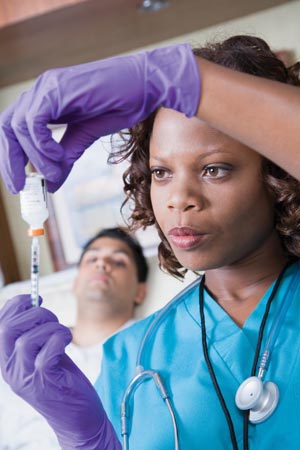DNP Nurses Use Research To Improve Patient Care
by Sara Michael
Every day, nurses impact the lives of their patients through their care and expertise. But it isn’t as often that an individual nurse can have a profound effect on hundreds of patients or more — by using their knowledge to improve a process.
And that’s just what several nurses have done after earning their Doctor of Nursing Practice in May. The DNP grads each found a problem, culled the relevant research, and applied that research to day-to-day practice.
“As a nurse, I wanted to feel like something I was doing was having a direct impact on patients,” said Joyce Maygers, DNP, RN, clinical outcomes coordinator at Johns Hopkins Bayview Medical Center, where she manages standards and processes of care. “And in this case, I was able to impact hundreds of patients.”
DNPs “take everything to another level,” Maygers said, and “contribute to the science and the profession beyond the unit level.”
By delving into existing research, and at times conducting their own surveys, DNP nurses can find the evidence that might have otherwise gone unused—and reduce the (often years-long) lag in getting research studies into practice. The DNP grads, some with clinical backgrounds, some with administrative expertise, have implemented changes beyond their own units and patients and at times been able to spread their findings across the country.
In the case of Linda Bartock, DNP, RN, vascular access services coordinator, her clinical scholarship on ways to reduce occlusion in PICC lines was published and is slated to be presented at a meeting of the Association for Vascular Access. “I am helping people at Bayview, and now my recommendations are going out nationwide,” she said.
The DNP program also taught these nurses “a whole new kind of nursing,” said Mary Anne Greene, DNP, RN, director of nursing education and practice at Bayview. After being a nurse for 40 years, Greene was skeptical she’d learn anything new. However, she said, “I learned tremendous amounts. I thought I knew evidence-based practice when I went into it, but I learned I didn’t know it.”
For her, it was a “whole new world of nursing,” one with databases and statistical analysis and in-depth review of articles to then translate into the real world.
“Research has never been my thing but applying research and improving practice, that’s what I am about,” she said.
For these recent graduates, the projects don’t stop with the completion of the capstone. In some cases, like Greene’s initiative to better reward nurse preceptors, the efforts will continue. Cindy Walters, DNP, RN, senior director of nursing at Johns Hopkins Bayview, started a program to improve patient safety by increasing nurse involvement in the patients’ plans of care. “Changing safety culture takes time,” she said, but staff has begun the journey and are reporting improvement in areas of patient care.
The DNP program has also given them a foundation for translating research into practice, said Shawna Mudd, DNP, CRNP, who sought ways to avoid an IV when administering a powerful pain medication to children. “It’s now having the skills and the foundation for putting that research into practice,” she said, “and looking at the outcomes.”
| Linda Bartock, DNP, RN,vascular access services coordinator, studied ways to reduce occlusions in PICC lines, a common occurrence at the hospital. Her clinical scholarship identified two new fixes which she implemented: using valves (rather than clamped) catheters and educating nursing staff on PICC line care. Mary Ann Greene, DNP, RN, director of nursing education and practice, sought to reward nursing preceptors, who serve as the “backbone of the organization.” She culled research and surveyed her own staff. She implemented an annual recognition program and is planning to recommend ways to rework the entire preceptor program. Joyce Maygers, DNP, RN, clinical outcomes coordinator, culled research on methods to reduce the rate and time of catheterization, a common cause of urinary tract infections. She has increased staff awareness around the use of catheters in patients in the neurosciences units. Shawna Mudd, DNP, CRNP, a pediatric nurse practitioner in the pediatric emergency department at The Johns Hopkins Hospital, sought to make the pain reliever Fentanyl available to children through a nasal spray, rather than an IV. Children often fear an IV, but Mudd was able to have the medication added to the formulary as a nasal spray, then facilitated implementation and measured outcomes related to its implementation. Cindy Walters, DNP, RN, senior director of nursing, implemented a comprehensive unit safety program, including training on the general medicine units. Outcomes of her efforts have included improved staff comfort in speaking up and asking questions about patient care. |
